AAFM GLO_CWM_LVL_1 Chartered Wealth Manager (CWM) Global Examination Exam Practice Test
Chartered Wealth Manager (CWM) Global Examination Questions and Answers
The Motor Vehicle Insurance Policy has inbuilt cover for death/disability of driver/owner caused by accident during the use of the insured motor vehicle up to Rs. __________ in case of car/commercial vehicle and Rs. _________ in case of two wheelers.
Commutation of pension up to a limit of _______________ is tax exempt in case the gratuity is also received
Purpose of budget is ____________
Which of the following statements in reference to REPO Rate is/are correct?
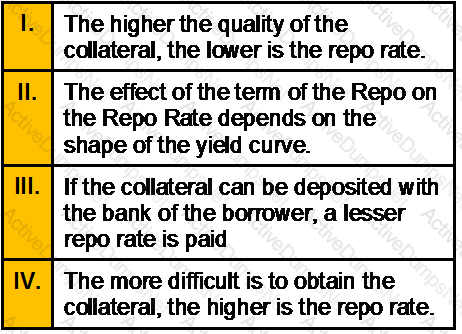
Which of the following statement is/are correct?
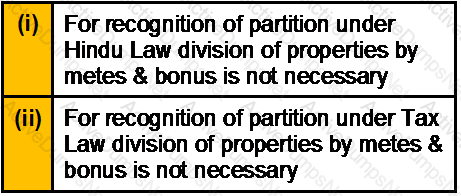
Basic Idea of retirement benefit plan is
Which of the following is / are RBI conditions applicable for banks declaring dividends?
Under the Workmen Compensation Policy, when the employment injury results in death, the insurance company pays 40 % of the monthly wages of the deceased multiplied by the relevant factor or Rs. _________ whichever is more.
Yash pays health insurance premiums for himself, his wife and his two children aged 13 and 8. Premiums for which of these individuals will qualify as deductible from Yash’s taxable income?
An increase in the market value of a company indicates:
What an employee should check in his retirement benefit plan offered by the employer?
A maximum of _____% of the trade done by a fund house can be routed through a single broker
A portfolio consists of 50% of investment ‘R’ that earned 10%, 25% of investment ‘S’ that earned 6% and 25% of investment ‘T’ that earned 9%. Compute the weighted average return?
If after the partition of an HUF 2 members became partners in 3 firms on behalf of their respective HUFs and they also become partners in a fourth firm. The funds were obtained by means of loans from the other 3 firms. The share incomes of the members from the fourth firm were assessable as their individual income only.
What is the future value of Rs. 5000 at the end of 5 years at 8% compounded annually?
Identify the placement techniques in the following statements:
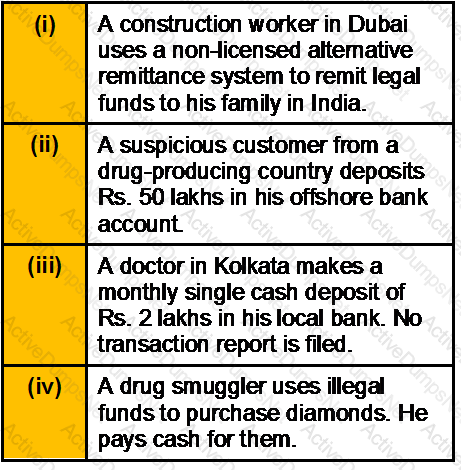
Financial markets have the basic function of
In a “Pure Play” model of wealth management
Which of the following can be described as involving direct finance?
Which of the following is a secondary identifier _______.
Sunil insured the building of his house for a sum of Rs.500000 against fire insurance. One day the house is totally gutted in a devastating fire. The insurance surveyors certified that the building is a total loss with no salvage value and that the insurable value of the building just prior to the loss was Rs.1000000. The insurer will pay to Sunil:
Ram is working in Rashid Enterprises, a proprietorship firm.During his working hours Ram was injured seriously. Due to this injury Ram was hospitalized for six months. Ram is the only bread winner of his family. Ms. Rashid, the proprietor of Rashid Enterprises is liable to pay damages to Ram. Under which of the following policy Rashid can protect himself from this liability?
Mr. Hitesh Shah has a portfolio with 23 different equities. The portfolio increased by 20% and has a beta of 1.50. Utilizing the Capital Asset Pricing Model, compute by what percent the market changed (round to nearest 0.5%) (Assume risk free rate of 5%)?
Mr. Dinesh is aged 35 years and has a wife aged 30 years old and two small children. His parents are also dependent on him and has a house against which he has taken a housing loan. What is the most important insurance cover required by him at this stage?
A central bank sale of ________ to purchase ________ in the foreign exchange market results in an equal rise in its international reserves and the monetary base.
Any income chargeable under the based "Salaries" is exempt from tax under Section 10(6)(viii), if it is received by any non resident individual as remuneration for services rendered in connection with his employment in a foreign ship where his total stay in India does not exceed a period days in that previous year.
How much should one deposit today in a bank account paying interest compounded quarterly if you wish to have Rs. 10000 at the end of 3 months, if the bank pays 5% annually?
Which of the following statements is/are correct?
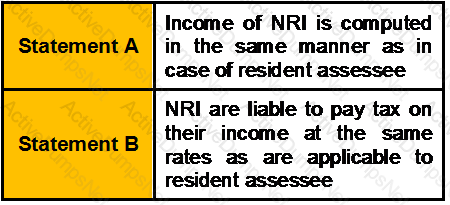
Mr.Dinesh is transferred to Delhi and is paid a shifting allowance of Rs.20000 by his employers out of which he spends Rs.18000 for shifting his family and personal effects. Which of the following is true?
Which of the following is an inferential data (i.e. data which may not be correctly obtained by simply asking a direct question)?
Which of the following statement is true?
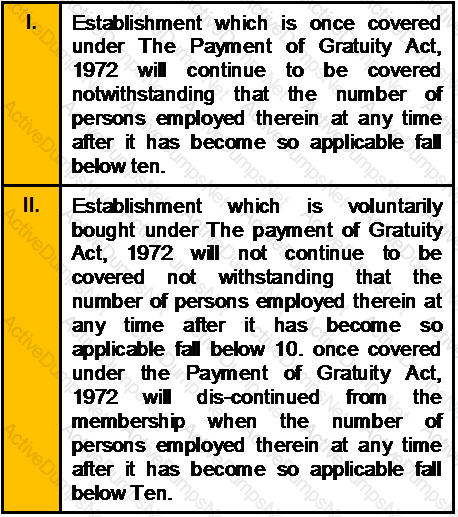
If the reserve ratio is 5%, what is the size of credit multiplier?
What is the minimum paid up capital needed to form a Pvt. Company?
Minimum number of independent directors on the board of asset Management Company is
During “Teen age years” life stage, typical asset allocation should be
The capital budget’s components are of a...................
Which of the following statement is correct?
Risk can be
Who would get the first preference when the property of a deceased person is to be distributed
Depreciation expenses would be classified as:
According to the capital asset pricing model, fairly priced securities have __________.
Share reflects a contribution in ownership of the company
For a “single income family” priority is on
Scholarship received by a student was Rs. 2,000 per month. He spends Rs. 15,000 for meeting the cost of education during the year. The treatment for the balance amount Rs. 9,000 is:
Interest paid to customers on the overdue period in case of delay in collection of cheque is debited to.
If any person has escaped assessment for any assessment year in respect of wealth tax no action shall be taken after the expiry of………
Which of the following is not a part of scheduled banking structure in India?
The risk measure used for calculating Treynor Index is:
According to the Gordon model, the discount rate used by the investors exhibits what type of relationship with the retention rate?
The Basel Committee has defined gross income as net interest income and plus net non-interest income and has allowed each relevant national supervisor to define gross income in accordance with the prevailing accounting practices. Accordingly the Reserve Bank of India in the draft guidelines issued on 11.03.2005 for implementation of the new capital adequacy framework has modified the Gross Income definition slightly. The Net Interest Income has been replaced by
HNWI stands for
Transfer of Property Act came into force on
A will that can only be made by a soldiers in actual warfare ,or airmmen or mariners at sea is known as:
The use of P/E ratios to select stocks suggests that
How many members are required to form a society?
Which one of the following is correct?

A lease which is short term in nature usually 3 years or less ,associated with high tech equipment or property which is prone to technological obsolesence
What is the minimum number of members required, to form a society under section 20 of the Societies Registration Act, 1860?
Which of the following are non-fund faced facilities?
In case of fire insurance, insurable interest should exist at the time of

Default risk is
Higher interest based on age is offered in which of the following accounts?
Minimum number of employees in an establishment for it to come under the purview of the Payment of Gratuity act is ______
The Indian Taxation System by nature is...........
Vinod joined on 01/01/90 in ABC Ltd. and retired on 01/01/2007.Employee paid leave encashment of Rs. 4,00,000/-. His last drawn salary is Rs. 25000/-. His last 10 months average salary is 23500/-. He availed 150 days leave during the service. What will be his taxable leave salary amount?
Calculate the death claim amount if the assured dies in the 25th year of the policy. Money back policy with SA of Rs. 50000. Term is 25 years. Survival benefits of 10% each paid at the end of 5th , 10th, 15th, and 20th years. Accrued bonus of Rs. 500 per thousand of SA.Interim bonus of Rs. 75 per 1000 of SA.
Dhruv contributes Rs. 25,000 every year starting from the beginning of the 4th year from today till the begning of 12th year in the account that gives a ROI of 11.40% p.a. compounded half yearly. Calculate the Present Value of his contribution today.
You are considering an investment with the following cash flows. Your required return is 8%, you generally require a payback of 3 years and a discounted payback of 4 years. If your objective is to maximize your wealth, should you take this investment?

What is the portfolios standard deviation if you put 25% of your money into stock A which has a standard deviation of 15% and rest into stocks B which has a standard deviation of 10%. The correlation coefficient between the returns of the stocks is .75.?
What is the surrender value, if the sum assured is Rs. 100,000/-, DOC is 01/01/1997, endowment with profit 25 years, due date of last premium paid 01/01/2010. Premium to be paid semi-annually. Accrued bonus is 500 per thousand of SA. Surrender value factor is 19% ?
Savitri is 30 years old. She saves Rs. 14,000/- p.a. (year end) in FD 8.75% p.a. compounded annually until she retires at age 58. Her life expectancy is 80 years. What would be her corpus at the time of retirement? What is the fixed amount she can withdraw at the beginning of each year, until age 80, in case she wishes to exhaust the whole corpus? Inflation is 5%.
Mr. Sushil, is 35 years old and working as a physician in a private hospital. He will retire at the age of 60. He is saving Rs. 30,000/- p.a. at the end of every year for past 5 years and will continue to save the same up to his retirement @ 7% p.a. His annual expenditure is Rs. 3,00,000/-. Life expectancy of Mr. Sushil is 75 years. On retirement, rate of interest is expected to be 6%. Calculate on retirement how much he can spend per annum if he leaves Rs. 5,00,000/- as estate for next generation?
Sachin aged 35 years is married and is working as a manager in M/s Birla Mill Ltd. His most likely retirement age is 60 years. His present salary is Rs. 3,00,000/- pa. His self-maintenance expenses are 30,000/- per year. Life insurance premium paid is 15,000/-. Income tax & professional tax amount to Rs. 20000/-. Rate of interest assumed for capitalization of future income is 8%. Calculate Sachin’s HLV to recommend adequate insurance cover
Pankaj is an employee of a private company in Jabalpur. He draws an amount of Rs 36,000pm as basic salary. He also receives Rs 8000 as HRA. He has taken a house on rent from 1st October and pays Rs 10,000pm as rent for his house accomodation. What would be the taxable HRA?
Mohan is a manager in ABC Co. Ltd. His family consists of his wife and child. It is assumed that his family needs a minimum of Rs. 10,000 per month to maintain current standard of life in unfortunate case of demise of Mohan. The interest rate is 6% pa. Calculate how much insurance is required under income replacement method?
The management of Pearls India Shopping Ltd has recently announced that expected dividends for the next three years will be as follows:
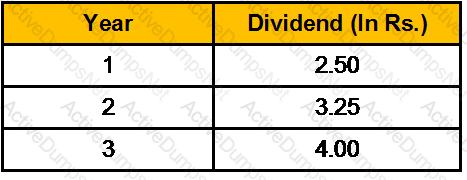
For the remaining years, the management expects the dividend to grow at 5% annually. If the risk-free rate is 4.30%, the return on the market is 10.30% and the firm’s beta is 1.40. What is the maximum price that you should pay for this stock?
Roger deposits Rs. 10,00,000 in a bank account on 1st March 2005 and another Rs. 5,00,000 on 1st March 2011. He wants to withdraw all of this money with interest on 1st March 2015. If the account pays ROI of 11% P.A. compounded quarterly what amount can he withdraw from this account?
Given the following information what is the expected return on the portfolio of two securities where both are held in equal weights?
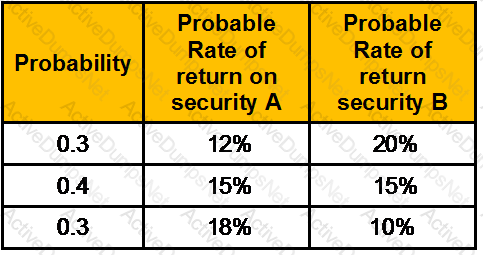
You are considering investing in a following bond:

Your income tax rate is 34 percent and your capital gains tax is effectively 10 percent. Capital gains taxes are paid at the time of maturity on the difference between the purchase price and par value. What is your post-tax approximate yield to maturity on this bond?
Omar wants to make a gift of Rs. 10000 in today’s terms to his parents at the end of each of next 10 years. If the annual rate of return is 8% and inflation is 3%, what is the value of funds he must have in hand today to meet this need for the 10 year period?
Mr. Ravi aged 28 years is a marketing professional who earns a salary of Rs. 50000 p.m. He is very concerned about his retirement expenses. For the same he has started saving Rs. 6000 p.m. regularly in a bank fixed deposit paying an interest of 9.5% p.a. since the age of 23.
At the age of 38, he is thinking of buying a house on his retirement which is 25 years away.
He has estimated that the price of the house at his retirement will be Rs. 4000000. Calculate the amount of retirement corpus accumulated by him and the extra savings he has to make at the age of 38 in order to purchase the house? (Inflation rate = 3% p.a.)
Akash owns a piece of land situated in Kolkata ( Date of acquisition : March 1, 1983, Cost of acquisition Rs. 20,000/- value adopted by Stamp duty authority at the time of purchase Rs. 45,000/-) On March 30, 2012 the piece of land is transferred for 4 lakh. Find out the capital gains chargeable to tax if the value adopted by the Stamp duty authority is 5.75 lakh. And X files an appeal under the Stamp Act and Stamp duty valuation has been reduced to Rs. 4.90 lakh by the Kolkata High Cout. [CII-12-13: 852,11-12: 785,10-11:711]
Mr. Patel expects the stock of A to sell for Rs. 70/- a year from now and to pay Rs. 4/- dividend. If the stock’s correlation with the Market is –0.3, and the standard deviation of A is 40% and standard deviation of the Market is 20% and the risk free rate of return is 5% and the market risk premium is 5% , what would be the price of stock A be now ?
Mr. Shyam has a portfolio consisting of two stocks A & B. Stock A has a standard deviation of 5 % while stock B has a standard deviation of 15%. Stock A comprises 40% of the portfolio and Stock B consists of 60%. If the correlation of returns of A& B is .5, the variance of return on the portfolio is _________.
A zero coupon bond of Rs 10,000 has a term to maturity of seven years and a market yield of 9 percent at the time of issue. What is the issue price? What is the duration of the bond? What is the modified duration of the bond?
Ankur Kalra is 33 years old finance professional. The house hold expenditure of Mr. Kalra is 20,000/- p.m. to maintain his current living standard. He assumes that his living standard will increase 1.5% annually until his retirement at 60. His life expectancy is 70 years. At retirement he needs 75% of his last year’s expenses. Inflation rate for the next 45 years is expected to be 4% p.a.
Calculate how much would Mr. Kalra require in the first year after his retirement, and how much he has to save at end of every year to accumulate this corpus, if the return on investment is 7% p.a.?
During the past five years, the returns on the stock were as follows:
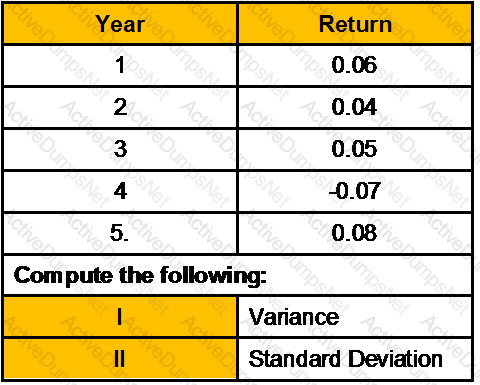
Ram purchased a house in Mumbai in March 2000 for Rs.3,50,000. In April,2011 he entered into an agreement to sell the property to Shyam for a consideration of Rs.19,75,000 and received earnest money of Rs.5,00,000. As per the terms of the agreement, the balance payment was to be made within 30 days of the agreement. If the intending purchaser does not make the payment within 30 days, the earnest money would be forfeited. As Shyam could not make the payment within the stipulated time the amount of Rs.5,00,000 was forfeited by Ram.
Which of the following statement is correct in respect of the above problem? [CII-12-13: 852,11-12: 785,10-11:711,84-85: 125]
Mr. John purchased a house in Mumbai in March 2010 for Rs.12,50,000. In April,2011 he entered into an agreement to sell the property to Mr. Akram for a consideration of Rs.19,75,000 and received earnest money of Rs. 50,000. As per the terms of the agreement, the balance payment was to be made within 30 days of the agreement. If the intending purchaser does not make the payment within 30 days, the earnest money would be forfeited. As Mr. Akram could not make the payment within the stipulated time the amount of Rs.50000 was forfeited by John. Subsequently John sold the house in June, 2011 for Rs.2130000. He paid 2% brokerage on sale of the house. Calculate the capital gains chargeable to tax for the assessment year 2012-13. [CII-12-13: 852,11-12: 785,10-11:711]
Which of the following statements is/are correct?
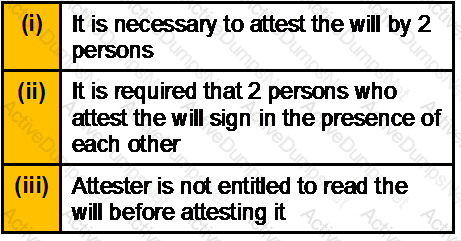
What is the present value of the following cash flows,if the Interest rate is 8%

Sudesh Haldia is employed at Delhi as Store Manager in one of the Retail Companies. The particulars of his salary for the previous year 2006-07 are as under:
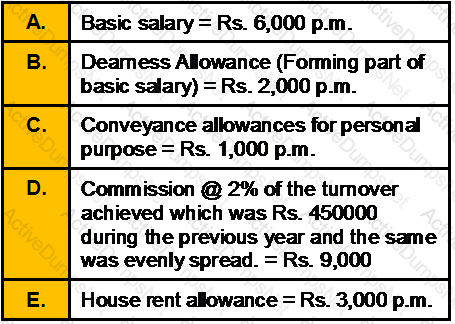
The actual rent paid by him is Rs. 2,000 p.m. for an accommodation at Noida till 31-12-2006.From 1-1-2007 the rent was increased to Rs. 4000 p.m. Compute the taxable HRA?
Alok a 28 years old person has joined SABH on 1/07/2006. His monthly salary (net salary) after deduction is payable Rs. 22500/. His monthly expenses details are as follows:
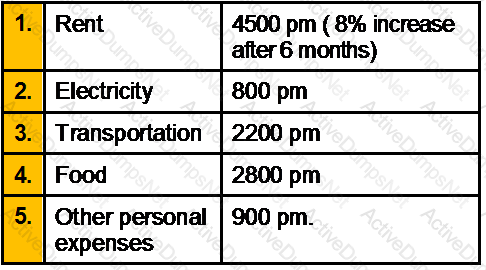
Assume Alok takes a flat on rent from 01 /07/2006. On 01 /07/2006 he has cash in hand Rs. 1450/-. He starts paying insurance premium from October @ Rs. 2500/- pm. His investments in Mutual fund SIP are Rs. 3000/- pm for a 6 month period. What will be his cash in hand on 31/03/2007.?
Mr. Kumar is a 40 year old NRI working abroad for past 5years. He invests Rs. 50, 000/- p.a. for past 5 years and wants to continue until his return to India. He plans to return to India after 10 years from now and enjoy his life back home. Inflation is expected to be 4% for next 30 years and his investment earns 6% interest. His expected life expectancy is 70 years. What would be his corpus at the time of return to India, and what amount he can with draw per month for his household expenses?
A rate of interest of 10% semi-annual compounded quarterly would be equal to -------------------- % per annum compounded annually.
R acquired a property by way of gift from his father in the previous year 1991-92 when its FMV was Rs. 3 lakh. The father had acquired the property in the previous year 1983-84 for Rs. 2 lakh. This property was introduced as capital contribution to a partnership firm in which R became a partner on 10/06/2011. The market value of the asset as on 10/06/2011 was 10 lakh, but it was recorded in the books of account of the firm at Rs. 8 lakh. Compute the capital gain chargeable in the hands of R.
Jensen measure of a portfolio reflects
Transfer of shares in the partnership firm is
Beta less than lies an indication that the security would move __________.
Which of the following statements with regard to Human Capital is/are correct?
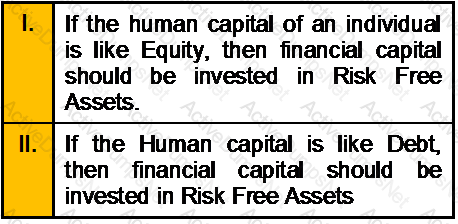
Which of the following is allowed as deduction from net annual value of a property?
The principle of _____________ ensures that an insured does not profit by insuring with multiple insurers
If the dispersion around a security's return is larger
How many sections are there in Householder’s Insurance Policy?
Consider two bonds, X and Y. Both bonds presently are selling at their par value of Rs.1000. Each pays interest of Rs.150 annually. Bond X will mature in 6 years while bond Y will mature in 7 years. If the yields to maturity on the two bonds decrease from 15% to 12%:
Forward contracts are
……………………is a gift in the form of a single transfer to the same person of several things of which one is and the others are not burdened by an obligation, the done can take nothing by the gift unless he accepts if fully.
If any expenditure is incurred by an Indian company wholly and exclusively for the purpose of amalgamation or demerger, the said expenditure is
Deposit insurance covers _______.
What is not the basic ingredient of a valid trust?
During “Early accumulation” life stage, typical asset allocation should be
The arbitrage pricing theory (APT) differs from the single-factor capital asset pricing model (CAPM) because the APT:
_______________ and _______________ mandates are two kinds of service level contracts
In addition to the contribution employer has to pay ______________% of wages as administration charges.
What is the minimum paid up capital needed to form a public limited company?
A good wealth management plan must include an analysis of all of the following EXCEPT
Mr. Kashyap took a business premise on lease with the provision that he himself had to pay the insurance premium for fire and other perils on the premises and not the owner of the premises. This would be an instance of_______________ on the part of owner of the premises.
At which of the three stages of money laundering is it generally easiest to detect money laundering activity?
Which of the following term means joint venture in Islamic Banking terminology?
If the income from a Private Trust originates from a business, then it is normally taxed.
What is ‘Mudharabah’
Criminals use ______ to camouflage money flow from criminal activities and pass it off as regular legal money flows.
If an assessed earns rent from a sub-tenant in respect to tenanted property let out as a residence, the said rent is:
Multi period hedging is ________
In case of resident of India, income from property situated in foreign country is taxable
Risk is
Fiscal Policy controls.....
Which of the following is controlled under monetary policy?
A Treasury bill pays a 6% rate of return. A risk averse investor __________ invest in a risky portfolio that pays 12% with a probability of 40% or 2% with a probability of 60% because __________.
Find Beta of security X if expected market premium is 15%, risk free return is 7% and expected return of security X is 20%?
How much loan can be given from PPF account in the year 2006-07?
Choose the amount of final tax liability of R for the assessment year 2007-08:
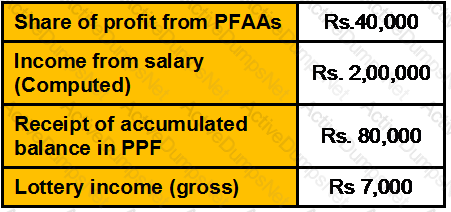
Any income chargeable under the based “Salaries” is exempt from tax under Section 10(6)(viii), if it is received by any non resident individual as remuneration for services rendered in connection with his employment in a foreign ship where his total stay in India does not exceed a period days in that previous year.
Investment in NRO may be made through _________.
Derive policy cost per thousand with following data:
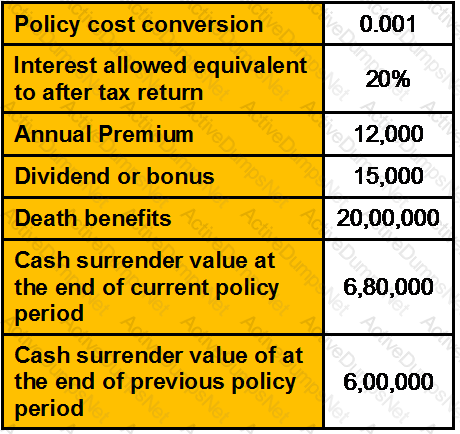
Vinod had taken a housing loan of Rs. 15 Lakh disbursed on 1st April 2006. They are presently paying an EMI of Rs. 17,285 at the end of every month beginning from the month of disbursement. The loan is at fixed rate of interest of 11.25% p.a. (reducing monthly balance basis) with tenure of 15 years. He wants to know what amount is eligible for deductible u/s 24 of Income Tax for housing loan repayments in computation of his Income tax liability for AY 2011-12.
Which of the following are investment intermediaries?
"A borrower who has been given notice of enforcement of security interest, replies with his objections. What is expected of the secured creditor? "
Rahul and Priyanka went to a wealth manager. Both of them have just got married. Their funds are limited and their needs are many.
Some of their needs are:
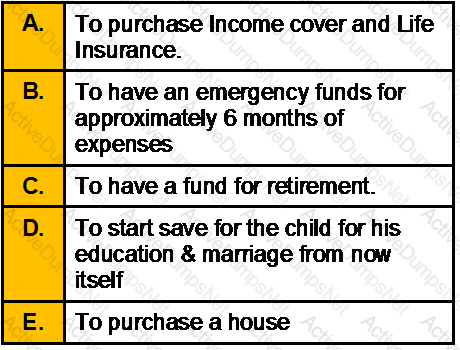
Kindly suggest the order in which they should start providing for their above needs:
"A borrower who has been given notice of enforcement of security interest, replies with his objections.
What is expected of the secured creditor?
Vinod opened the PPF account on 19/11/2000, Calculate the amount he can avail as the first loan facility from the details below?
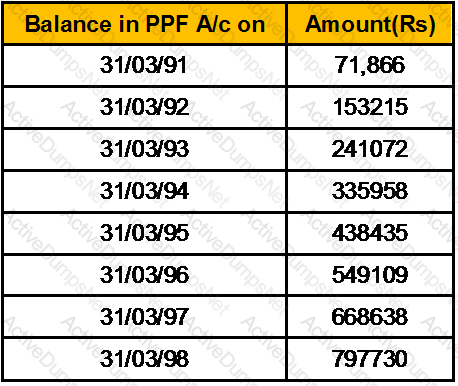
The shares of Alpha were bought on Jan 1 for Rs 110/-. During the year Alpha paid a dividend of Rs 2/- per share. At the end of the year, share of Alpha was sold for Rs 115/- What is the total return on Alpha?
Economists group commercial banks, savings and loan associations, credit unions, mutual funds, mutual savings banks, insurance companies, pension funds, and finance companies together under the heading financial intermediaries. Financial intermediaries
You are given the following set of data:
Historical Rate of Return
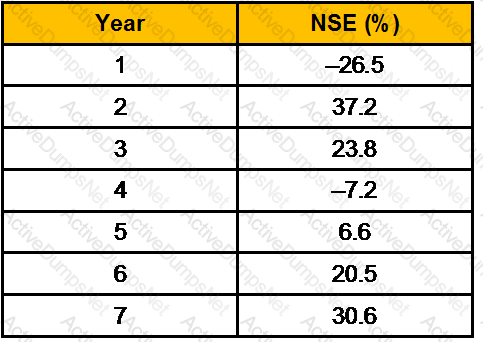
Determine the arithmetic average rates of return and standard deviation of returns of the NSE over the period given.
Girish is 25 years old and plans to retire at 60. His life expectancy is 75 years. Mr. Binoy his CWM® estimates that his client will require Rs. 45,000 in the first month after retirement. Inflation rate is 5% p.a. and the rate of return is 7% p.a. How much she should save every year in order to achieve her post retirement needs?
CAMELS framework was first used in _______.
Ramesh has invested Rs. 70,000, 30% of which is invested in Company A, which has an expected rate of return of 15%, and 70% of which is invested in Company B, with an expected return of 12%. What is the expected percentage rate of return?
You bought a stock for Rs. 20 and sold it for Rs. 59.72 after six years. What was the annual rate of return?
Why do criminals launder money?
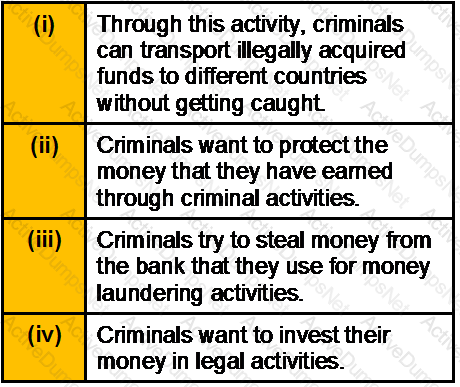
Encashment of leave during service tenure is
Mr. Shivam Sharma expects to receive Rs 25000 in net receipts each year for five year and to sell the property for Rs 350,000 at the end of the five-year period, if Mr. Sharma expects a 15% return, what would be the value of the property?
A doctor has taken a professional indemnity Policy on 01/06/2003 and has been continuously renewing it. In August, 2006 he operated on an infant child. But that operation failed. The parent of child filed a law suit against doctor in Sept, 2006. Which of the following statement is true in respect of the claim?
Broadly, world over the minimum investable assets for MULTI FAMILY OFFICE SEGMENT is :
The difference between aggregate disbursements net of debt repayments and recovery of loans and revenue receipts and non debt capital receipts is called:
Mr. Gupta has got his stock insured against fire for Rs5,00,000/- ,during the year he lost the stock in his ware house for Rs. 4,00,000/-. The surveyor from insurance company gave his report that at the time of fire the stock in the ware house had value 6,00,000/-
Calculate what amount Mr. Gupta will receive from the insurance company.
When cash flows occur at the beginning of each period, it is called as ___________
Concept of final pay is a feature of
Which of the following taxes are allowed as deduction while computing the business income?
